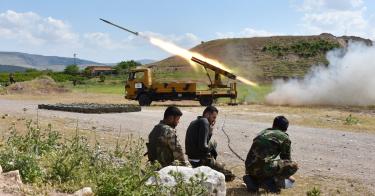It’s hard to conceive that the situation in Syria could get any worse—but it might.
Besides the tremendous bloodshed during the eight-year-old civil war—that included the rise and fall of the Islamic State—the world witnessed the Syrian regime’s almost unbridled use of chemical weapons to savagely work to break its opponents’ will.
Indeed, the regime’s use of chemical weapons such as chlorine, mustard gas, and sarin nerve agent may not be over. Just last week there were reports that the regime used chemical weapons again, this time in the northwest part of the country.
The regime’s fondness for chemical weapons has long been known. Besides previous allegations of chemical weapons use in the civil war, Syrian government forces infamously struck with sarin at Ghouta in 2013. That brought pressure from the United States, which led Syria to agree to declare its holdings, make them available for destruction and accede to the Chemical Weapons Convention.
It turned out to be a ruse.
In 2017, Damascus again used sarin, this time in Khan Shaykhun, which killed nearly one hundred and injured several hundred more. A joint United Nations-Organization for the Prohibition of Chemical Weapons investigation attributed the attack to the regime.
Of course, Damascus denies ever using weapons of mass destruction (WMD), but according to a State Department spokesperson, citing UN work: “the [Bashar al] Assad regime itself has conducted almost all verified chemical weapons attacks….”
While numbers are inexact due to the challenges of investigating such incidents in a country embroiled in conflict, some believe that from 2012 to the present, the Assad regime has used chemical weapons more than three hundred times.
The Islamic State also is accused of using chemical weapons in Syria, but on a much more limited scale.)
While the Syrian Civil War may be far from settled, the brutal Assad regime seems likely to survive, retaining power over a good portion—and perhaps more—of the deeply traumatized country.
Given Russia’s political and military support—as well as its own use of chemical weapons in the United Kingdom—it’ll be exceedingly difficult to get Syria to give up its chemical weapons arsenal or hold Damascus accountable for its heinous use.
This is bad enough, but it could get worse.
The Iranians seemingly plan to use Syria as a forward operating base, giving it strategic proximity to Israel. Likewise, the Lebanese terrorist group, Hezbollah, will likely stay in Syria to support Damascus while developing options to threaten Jerusalem.
It begs the question: With the Assad regime’s assistance, could offensive chemical weapons become an arrow in the quiver of Iran’s Islamic Revolutionary Guard Corps and/or Hezbollah—if they haven’t added this capability already?
With existing concerns about an Iranian chemical weapons program, it’s hard to rule out the possibility that such threats won’t emerge to challenge both U.S. and Israeli interests.
Chemical weapons may also not prove to be the end of Syria’s relationship with WMD, either. Another possible longer-term concern is whether Syria will reconsider a nuclear program, despite its Nuclear Non-Proliferation Treaty commitments.
It wouldn’t be the first time.
In September 2007, an Israeli air raid destroyed a secret, North Korea-supported nuclear facility at Al Kibar, Syria. The Syrian nuclear program was believed to have had a military dimension including the production of plutonium that could be used for weapons.
While the nuclear reactor was demolished in the Israeli strike—with the Syrians covering up any of the remaining evidence as best they could—the nuclear know-how, the scientists and other associated facilities may have survived.
This possibility would certainly be helpful should Syria decide to reconstitute its nuclear program. Outside assistance could once again come from North Korea or even Iran, accelerating Syria’s drive for a nuclear weapon.
From a strategic perspective, it makes sense that Syria could decide to pursue another nuclear program with military purposes to protect and advance its interests, especially in light of its recent experiences.
Nothing says deterrence like a nuclear weapon.
While there are questions about whether a nuclear program would be a priority for Damascus during or after its debilitating civil war—or that resources would be available to reestablish a nuclear program—the possibility must be taken into account.
Syria will almost certainly remain a rogue state under Assad, operating outside the constraints of international norms.
Whether it is chemical weapons or nuclear weapons, the international community should work not only to hold Syria accountable for its actions involving chemical weapons, but also to ensure that the Syrian WMD problem doesn’t get worse.
This piece originally appeared in The National Interest



